
16 minute read
Carrying Forward the Spirit
200 years after Elizabeth Seton’s death, Cincinnati SCs follow in her spirit
By S. Judith Metz
Advertisement
Rare is the Sister of Charity of took a canal boat to Dayton where they Cincinnati who has not ministered opened St. Mary’s Academy and free in the Archdiocese of Cincinnati. school, and two years later traveled to Just eight years after the diocese was St. Patrick’s in Fayetteville to open a established in 1821, the Sisters of Charity boarding school for boys and a free school began their service. Since, they have been for village children. With the outbreak a permanent and pervasive presence in of the Civil War in 1861 a majority of church ministries of education, health care the Sisters served the sick and wounded and social outreach in many cities and small soldiers in military hospitals from the east towns throughout the diocese. In doing so coast to the Mississippi River as well as at they were inspired by their founder, St. John’s Hospital. St. Elizabeth Seton, who expressed the Between the Civil War and the end spirit of the Community when she wrote of the 19th century the Sisters followed of the joy she felt “at the prospect of the roads, canals, and railroads north and being able to assist the poor, visit the east from Cincinnati to serve in schools sick, comfort the sorrowful, clothe little from Glendale to Findlay; from Marion innocents, and teach them to love God.” In 1854 the Sisters of to Chillicothe to Portsmouth. Meanwhile
Elizabeth Seton had a deep desire to Charity established Mount the number of schools in Cincinnati teach poor children but economic necessity St. Vincent Academy in Price multiplied to include northside, Mount determined that she open a pay school Hill (Cincinnati); today the Adams, Madisonville, and norwood. By where students’ fees could support serving school is known as Seton the early 1900s the Sisters were educating the poor. She also never lost her desire to High School. well over 8,500 children per year in parish provide care for the sick, visit the poor schools, orphanages, and academies in their homes, and assist the needy in any way possible. The throughout the archdiocese. Cincinnati Sisters embraced this vision. In addition to opening To serve the needs of the schools the Community a pay school, free school, and girls orphan asylum in 1829, they continually worked to strengthen normal school training for worked with the Martha and Mary Society to assist the poor, Sister-teachers. Community supervisors and a school board and nursed during periodic cholera epidemics. oversaw their work and published courses of study. The Sisters
Their ministries grew through the 1830s and 1840s as attended six-week summer courses and continued their work did the number of Sisters working in Cincinnati. However during the school year studying to pass exams required to when superiors at their motherhouse decided to join the French teach specific grades. As high schools began to proliferate, the Daughters of Charity, six of the Sisters in Cincinnati chose Sisters received additional opportunities to attend summer and a different direction. Wishing to continue Elizabeth Seton’s Saturday classes at local colleges and universities. original vision of serving the American church, they applied to While many Sisters were involved in classroom education, Archbishop John Purcell who supported them in establishing others ministered in health care and social outreach. St. Joseph’s a diocesan community under the leadership of S. Margaret Infant and Maternity Home founded in 1873 provided a George in 1852. unique service in the archdiocese. Besides caring for young opening a novitiate and accepting new members mothers and their newborns, St. Joseph served as a maternity their numbers swelled, allowing the Sisters to expand their hospital for neighboring communities. In addition, while many ministries. Within two months of their founding, St. Joseph’s babies were adopted, others resided at the home until they were Boys orphan Asylum opened and in november Bishop John transferred to St. Joseph orphanage. The Sisters conducted Purcell purchased property where the Sisters started St. John’s a preschool and kindergarten for these children, as well as (later Good Samaritan) Hospital. Soon the Sisters opened new providing prenatal instruction for the expectant mothers. In schools in Cincinnati, including Mount St. Vincent Academy 1976 St. Joseph’s changed its focus to caring for individuals in Price Hill (later Seton High School). By 1857 four Sisters with complex disabilities, a service it continues to offer.
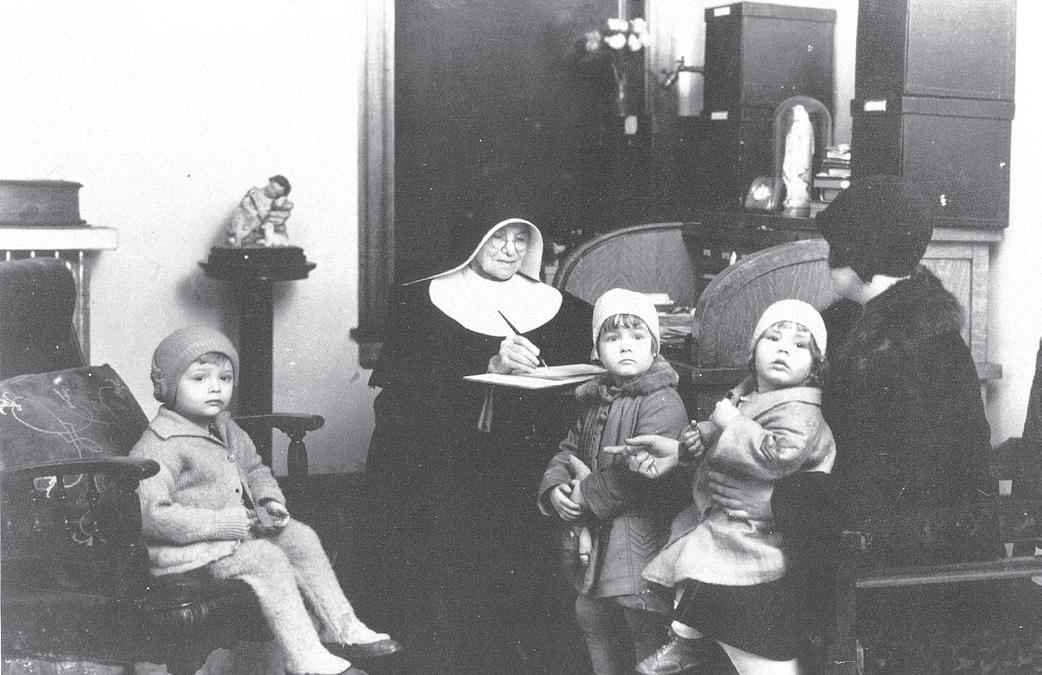
The Sisters of Charity established The Santa Maria Educational and Industrial Home in 1897 as a settlement house to serve Cincinnati’s Italian immigrant population.
changing need of students led to the college becoming Mount St. Joseph University in 2014. Through the decades from the 1920s through the 1960s the number of Sisters grew as did their ministries. By the end of 1960s, however, many changes in our society, the Church, and the Congregation dictated new approaches to their work. Fewer Sisters worked in classrooms, but new work as campus ministers, pastoral ministers, directors of religious education, and hospital chaplains became available. In addition, Sisters founded organizations such as The Literacy network, Bethany House, Working in neighborhoods, the Intercommunity Justice and Peace Center, The Women’s Connection, Seton Family Center and EarthConnection. Sisters worked in the Archdiocesan Education office and on boards of educational and social service organizations. In the 1980s the Community moved into ministry to the elderly with the founding of Eldermount, and a few years later opened Bayley, a retirement and wellness community serving senior citizens. DePaul Cristo Rey High other endeavors included The School, distinguished by its uniquely Santa Maria Educational and Industrial affordable college prep curriculum and Home that has offered an array of services its innovative work program, opened for immigrants and the needy since its in 2011. beginning in 1897. This first Catholic settlement house in the United States Through their 192 years ministering pioneered modern methods of social in the Archdiocese of Cincinnati, service delivery and continues to do so. the Sisters of Charity have touched In 1915 the Sisters of Charity began hundreds of thousands of lives through their work in deaf education at St. Rita their educational, health care and social School for the Deaf. Sisters continued service endeavors. In doing so they to staff the school into the 21st century have endeavored to follow in the spirit adopting updated educational programs In May 1997 S. Mary Jo Gasdorf of their founder, Saint Elizabeth Seton, and methods as well as providing many established The Women’s with the unrelenting goal “to assist enrichment activities for their students. Connection, a holistic center the poor, visit the sick, comfort the When Springer School was designated offering programs to meet the sorrowful, clothe little innocents and a school for children with learning disabilities beginning in 1943, Sisters of Charity staffed it. By the 1960s the Sisters needs of women and families in the Price Hill (Cincinnati) community. teach them to love God.” there developed an avant-garde program that has made the school a national leader in its field.
In addition to Good Samaritan Hospital in Cincinnati, the Sisters also conducted Seton Hospital in Cincinnati (18971924), and Good Samaritan Hospital in Dayton (1932-2018). All three of these institutions sponsored schools of nursing beginning in 1896 when the Cincinnati hospital opened its school, now the Good Samaritan College of nursing. The hospital also conducted a school for medical technologists, a dietetic internship, a school of practical nursing, and an X-Ray technicians training program. After staffing numerous elementary schools and a growing number of high schools, the Sisters opened the College of Mount St. Joseph in 1920 as the first Catholic women’s college S. Florentine Bunline was one of many Sisters of Charity of Cincinnati who have ministered at Good Samaritan Hospital in Cincinnati since its chartered in the state of ohio. Through the years growing beginnings in 1852. enrollment, the addition and expansion of programs, and the

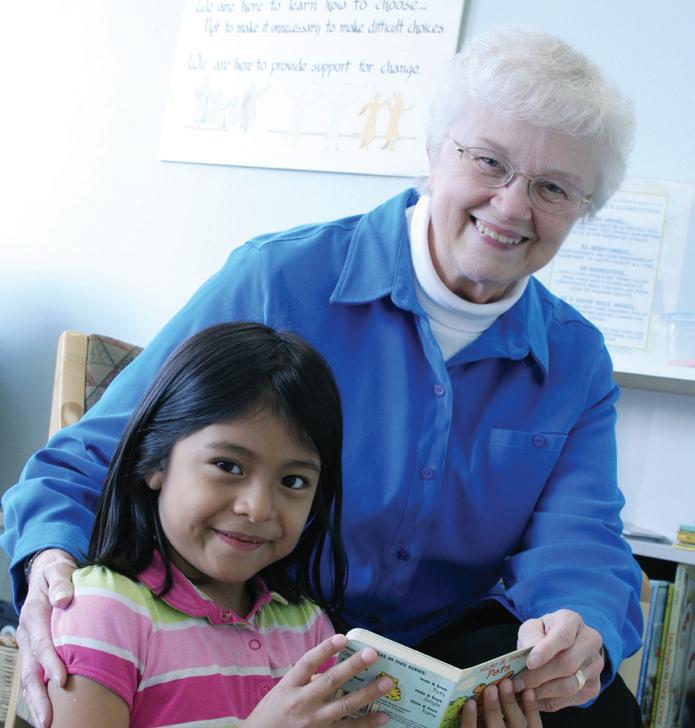
Re-Imagining a Motherhouse
By S. Dorothy Ann Blatnica
When five Vincentian Sisters chapel, also in-the-round. The exterior of Charity of Pittsburgh focal point was its bell tower with arrived on Sept. 4, 1928 authentic cast iron bells purchased from on the Bedford, ohio property a parish church in Maryland. Those donated to them by Cleveland’s Bishop bells announced the daily and special Joseph Schrembs, little did they realize events of the life of the Sisters from how that property would evolve in the the noon and six o’clock ringing of the coming years. In not quite a century, Angelus to celebrations and funerals. the mansion they greeted would one It would peal and toll as the situation day become a modern apartment required. As Sisters retired and returned complex. to live at the Motherhouse, the bells
At the time their minds were fixed continued to remind their Bedford on turning the empty and some-what neighbors that their needs were held in neglected mansion into a suitable prayer by the Sisters. Those neighbors convent in order to begin their new took saddened notice when the bells teaching ministry in the Diocese rang for the last time in 2010 when the of Cleveland. on Sept. 10 Bishop last group of Sisters moved from the Schrembs blessed the property and Motherhouse. named it Villa San Bernardo to honor The stained-glass windows in the chapel of the present During the decades of the 1980s community room of Villa San Bernardo remain due to Bernard Schatzinger and his family who their historical designation. and 1990s, changes in the Church and had donated the 20-plus acre estate to in American life precipitated changes the diocese. Within several weeks three young women joined in the membership of American Catholic religious life. Fewer the Sisters as their newest members. By February 1931, the new members and aging older members demanded new cornerstone of a new convent addition was blessed, and in visions for the ongoing life of Catholic women religious. The February 1939, the Vincentian Sisters of Charity in Bedford Vincentian Sisters took this challenge seriously and entered received approval from Rome to be a diocesan congregation into a process of discernment regarding their future as a of women religious. The convent which housed them became congregation of 50 members. This process of research and their official headquarters or “Motherhouse” and would reflection led to a unanimous decision that they needed to remain so for the next 65 years. seek membership with another congregation of Sisters if their
During those next six decades physical changes were mission and charism were to continue into the future. They made to the Motherhouse building to make it compatible became members of the Sisters of Charity of Cincinnati who with the growing numbers of Sisters. Porches were added to welcomed their new Sisters with warmth and friendship in the exterior of the building, rooms were added to the interior, 2004. and a chapel was designed as the central focus of the entrance. This decision created what would become a major Sisters experienced their initial formation within its walls and change for Villa San Bernardo. no longer a Motherhouse or were sent to various ministry assignments throughout the administrative headquarters, the property became a retirement Cleveland diocese. The congregation’s administrative offices home for the Sisters living there. In time these Sisters moved were housed within these walls as well. to the Motherhouse in Cincinnati and the decision was
In time, however, the oldest section of the Motherhouse made to sell the Bedford property. The sale proved to be – the “mansion” – began to show its age in a way that called challenging because of the structure of the hilly landscape for decisive action. From 1977 to 1979, the mansion was and large buildings which did not easily support a parceling completely razed and in its place a modern extension of the of the property. To sell meant to let go of control over what 1931 wing of the Motherhouse was built. It housed a modern a buyer might choose to do with the property. The legacy of kitchen and food service area, a dining room in-the-round, spirituality, education and charitable works could potentially administrative offices, bedrooms, conference room and a be forgotten and lost forever. The heavenly housed Vincentian
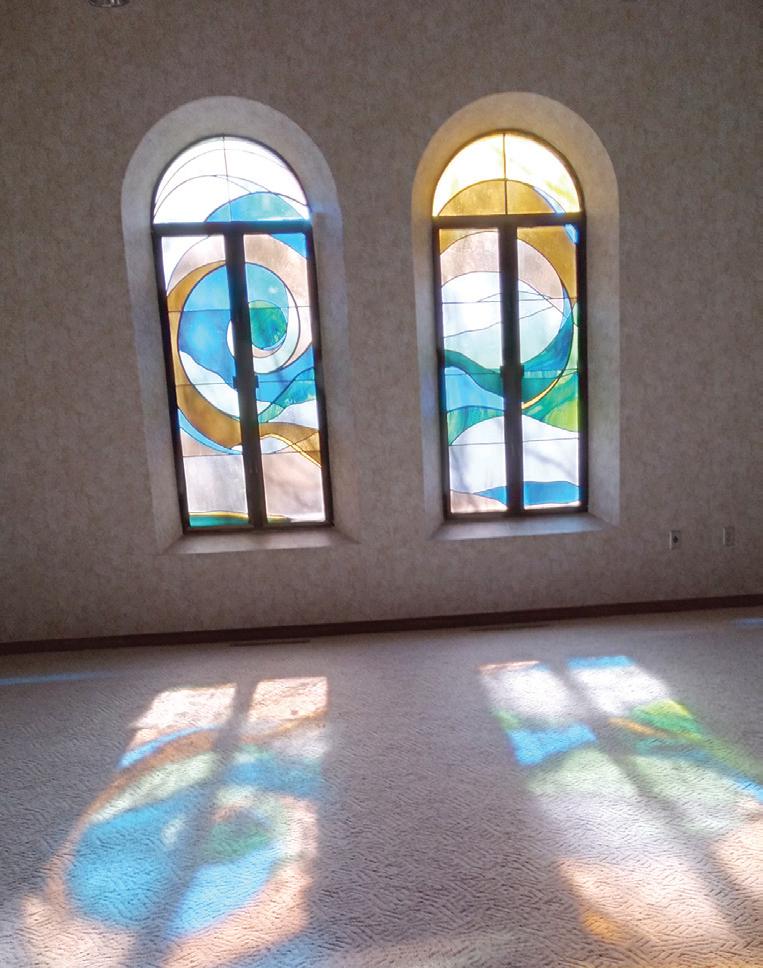
Sisters were barraged Most importantly, the new residents fulfill the with prayers that a new mission and charism of the earlier Sister-residents. Though owner would be found they are a diverse population they share the experience of who would value the aging on limited incomes, lack of housing choices, failing Vincentian legacy as neighborhoods, and unsuitable living conditions. They well as the property delight in their independence and in setting up house in itself. a clean, safe and quiet environment. Though no longer In March 2014, religiously identified, Villa San Bernardo bestows a sense of the Testa Companies peace on so many of the residents that they feel compelled to of Cuyahoga Falls, express it. Catholic or not, many are appreciative of the Sisters ohio came to view who lived and worked on this property and feel honored to the property. The live here. Signs of the former residents still dot the property history and legacy of and are gentle reminders of the love that nurtured a longthe property and the lasting identity still to be continued. Sisters were shared and Vincentian Pathways was created in 2017 to honor the a thorough inspection Sisters who developed this property. Eight acres of woods of the buildings was and green space which wrap around the west side of Villa San conducted. Initially Bernardo will provide the apartment residents a quiet place to Villa San Bernardo offers a clean, safe, welcoming environment to its diverse Testa said they enjoy the outdoors. As a nonprofit, Vincentian Pathways will population of residents. only wanted the always maintain this gem of natural beauty. Motherhouse building, but after more consideration of the possibilities a purchase agreement was made with the Sisters of Charity. During the ensuing months the original property of 23 acres was placed on the national Registry of Historic Places as a “historic district” in honor of the educational and spiritual endeavors of the Vincentians and their ministry to the Slovak Catholics of the Cleveland Diocese through the Shrine of our Lady of Levocha. Ultimately the entire property of Villa San Bernardo was purchased by the Testa Companies in 2016. When asked what the property would be named, their answer was immediate: “The property has a name – Villa San Bernardo.”
Testa’s vision for the property was to create new, affordable, independent housing for lower income seniors age 55 and older. Fifty-nine modern one- to two-bedroom apartments were designed for the total retrofitting of both the Motherhouse and Retreat House buildings. not surprisingly those two names were also retained for these buildings. Because of the historic designation, certain areas of these buildings could not be changed: the long hallway at the Retreat House, the hallway and former chaplain’s quarters at the Motherhouse, and certain features such as leaded glass windows, chandeliers and the chapel ceiling and stained-glass windows.

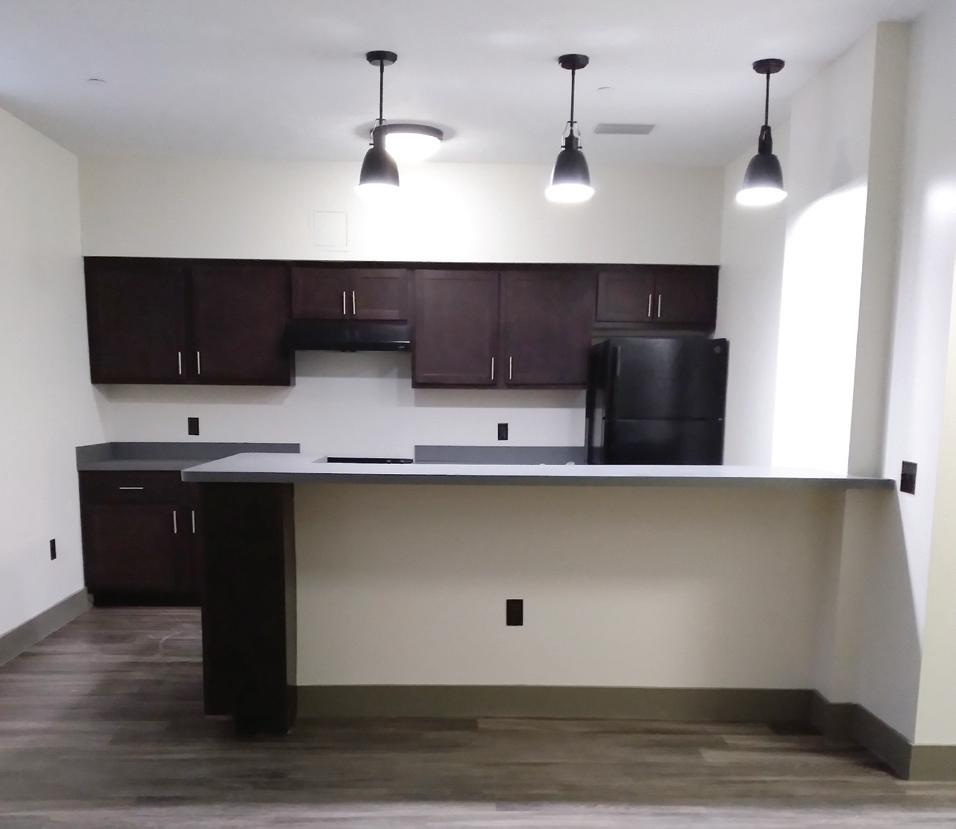
The inside of the newly remodeled apartments at Villa San Bernardo in Bedford, Ohio.
Villa San Bernardo, the former Motherhouse of the Vincentian Sisters of Charity, is now home to 59 affordable, independent housing units for lower income seniors age 55 and older.

Catholic Sisters Week:
Celebrating Traditions, Changing the World
In March Sisters of Charity employees joined others across the country to celebrate Catholic Sisters Week. The weeklong, annual event shines a spotlight on women religious and encourages all who follow Jesus to expand and support their Gospel witness as well as share in their spirituality, charisms and community.
In previous years SC employees have planned activities at the Motherhouse to honor the Sisters and celebrate their lives of service and love. Due to the pandemic and campus guidelines, this year the Community and its employees partnered with more than 80 other women’s religious congregations to bring awareness to a growing food insecurity issue in the United States. The CoVID-19 pandemic has affected people of all walks of life, but with no safe, secure place to call home, the homeless population has especially felt the gravity of our current reality.
Throughout the week Motherhouse and Mother Margaret Hall employees collected more than 1,620 nonperishable and personal hygiene items for Community Matters Food Pantry. Donations were delivered on March 18 to a grateful staff. A heartfelt thank you to the Sisters of Charity employees for their donations; their kindness and generosity is a testament to a true commitment to the mission and spirit of the Community.
In addition to the food collection, Sisters living in Mother Margaret Hall and the Motherhouse each received a single flower as a sign of appreciation for their faithful years of service to others. The Sisters of Charity Communications office honored the Community’s 226 SCs with a video celebrating each Sister. To view the video visit www.srcharitycinti.org/2021/03/11/celebrating-our-sisters/.
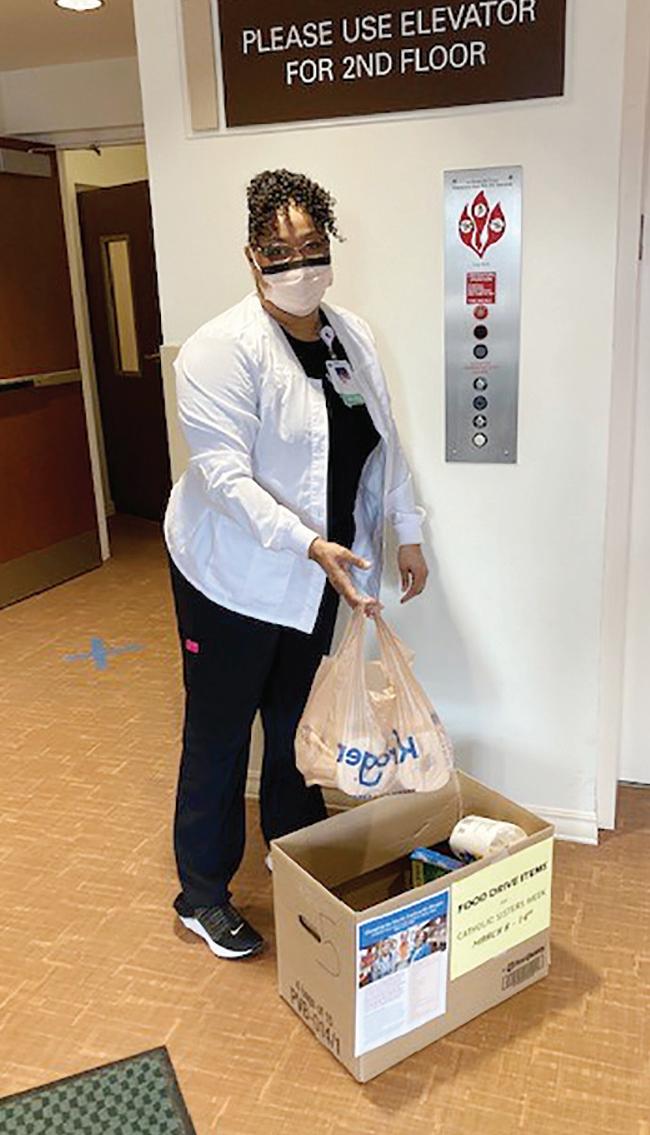
Throughout the week of March 8-14, Sisters of Charity employees in the Motherhouse and Mother Margaret Hall brought in items to donate to Community Matters Food Pantry.
S. Ann David Wojtylka smiles with the flower she received from Human Resources and the SC employees during Catholic Sisters Week.

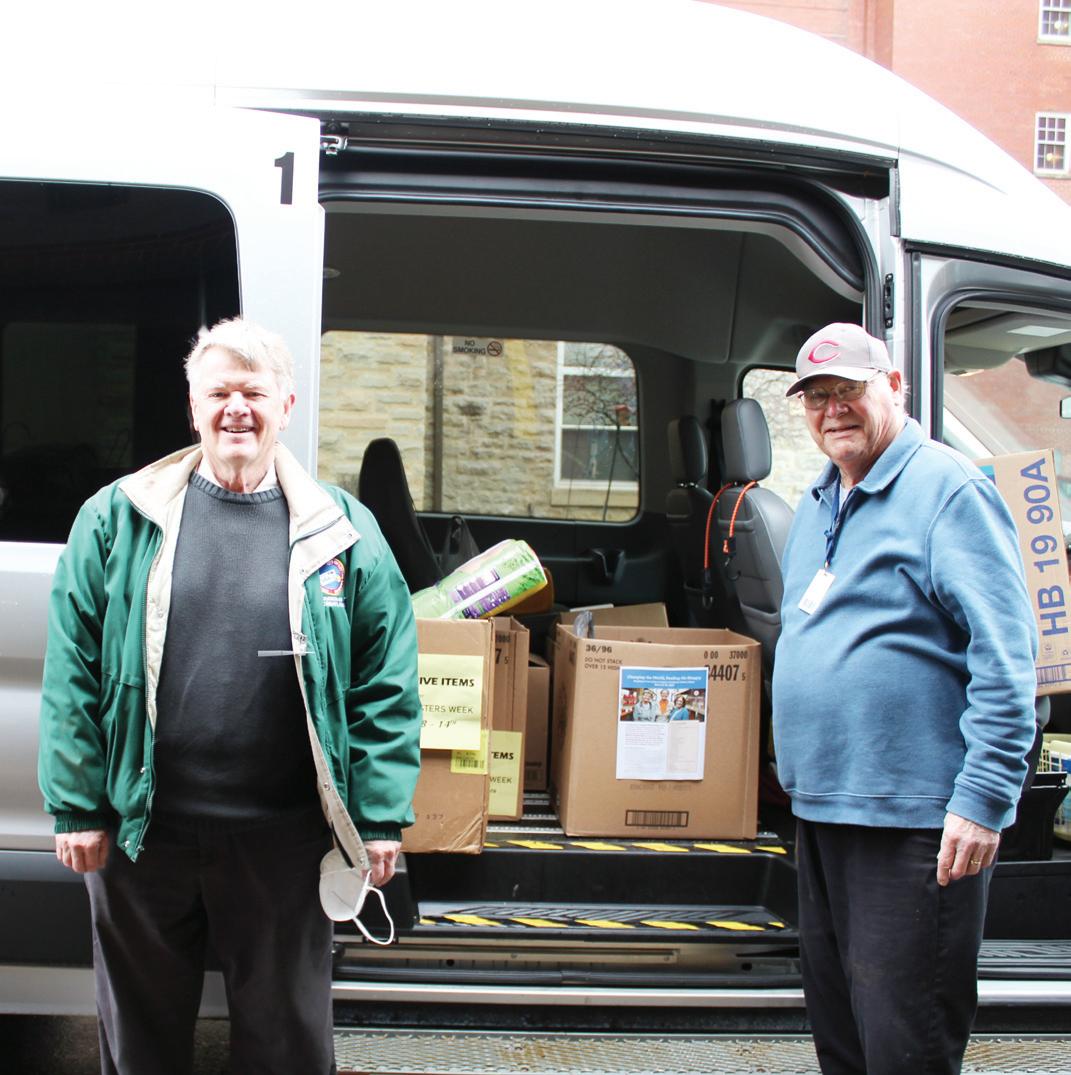
Items collected during the Catholic Sisters Week food drive were delivered to Community Matters Food Pantry the following week.

More than 1,620 nonperishable and personal hygiene items were donated to a grateful staff at Community Matters in Cincinnati, Ohio.
About community matters
Community Matters works to create a thriving and more just community by removing barriers to opportunity. one of the ways they are able to do so is with the Community Market Pantry, a choice food pantry that provides a dignified shopping experience for families experiencing need. Customers shop for free and with the opportunity to select items that meet the needs of their family. In addition to nonperishable, shelfstable foods, fresh produce, breads, dairy products, and meats are available. The Community Market also offers hygiene products and household cleaning items, which are not covered by food assistance benefits. It is often the first step for families to meet staff and begin on a path towards self-sufficiency.
During the CoVID-19 pandemic, the Community Market has been able to pivot by connecting with Lower Price Hill families through phone calls and online chats to offer emergency support through the delivery of items directly to the doorsteps of their neighbors. By mid-April of last year, demand for the pantry alone nearly doubled, and families were (and still are) requesting food and supplies more frequently.
Sister of Charity of Cincinnati Mary Ann Humbert has been a faithful volunteer to the food pantry for a number of years. She has enjoyed getting to meet the families in the neighborhood as she assists shoppers, bags food items, stocks shelves and collects pantry items. She enjoys seeing familiar faces stop by and as she gets to know them, they are more and more comfortable confiding in her. Her listening ear has been a source of comfort and support.
If you or your organization is interested in hosting a food drive for Community Matters, contact 513-2442214. For more information about the organization visit www.cmcincy.org.

S. Mary Ann Humbert (left) has been a faithful volunteer at Community Matters Food Pantry.










